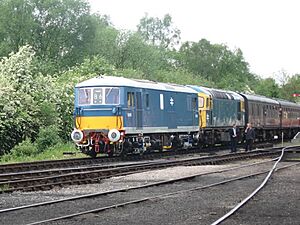Multiple working facts for kids
Multiple working is a special way trains are controlled in the United Kingdom. It means connecting two or more diesel or electric locomotives together. The cool part is that only one driver controls all of them! This makes it easier to move very long or heavy trains.
This idea also works for "multiple unit" trains. These are trains where the engines are built right into the passenger cars. When two or more of these trains are linked, one driver can control them all.
Sometimes, you might hear the term "in tandem." This is different. "In tandem" means two or more locomotives are pulling a train, but each locomotive has its own driver. So, multiple working is about one driver controlling many engines, while "in tandem" means many drivers for many engines.
Contents
How Multiple Working Operates
Multiple working allows a single train driver to control several locomotives at once. Imagine needing a lot of power to pull a very heavy freight train or a long passenger train. Instead of having a driver in each engine, multiple working lets one person do the job.
Connecting the Locomotives
To make multiple working happen, the locomotives need to be connected in two main ways:
- Mechanically: They are physically coupled together with strong connectors, just like any train cars.
- Electrically/Pneumatically: Special cables and air hoses link the control systems. These connections send signals from the lead locomotive to all the others. This way, when the driver speeds up or brakes the first engine, the others do the exact same thing.
Why Use Multiple Working?
There are several good reasons why train companies use multiple working:
- More Power: It provides extra pulling power for heavy loads or steep hills.
- Longer Trains: It allows for much longer trains, which can carry more passengers or goods.
- Flexibility: It makes it easy to add or remove power as needed for different routes or train sizes.
- Efficiency: One driver can manage a lot of power, which saves on staffing costs.
What Happens if an Engine Fails?
Even if one of the locomotives in a multiple working setup has a problem, the driver can often still control the other engines. As long as the broken locomotive can still pass along air and electricity, the signals can reach the working engines behind it. This helps keep the train moving, even if at a slower speed, until it can reach a repair depot.
Images for kids
-
Blue Star multiple working equipment on a Class 40 locomotive




